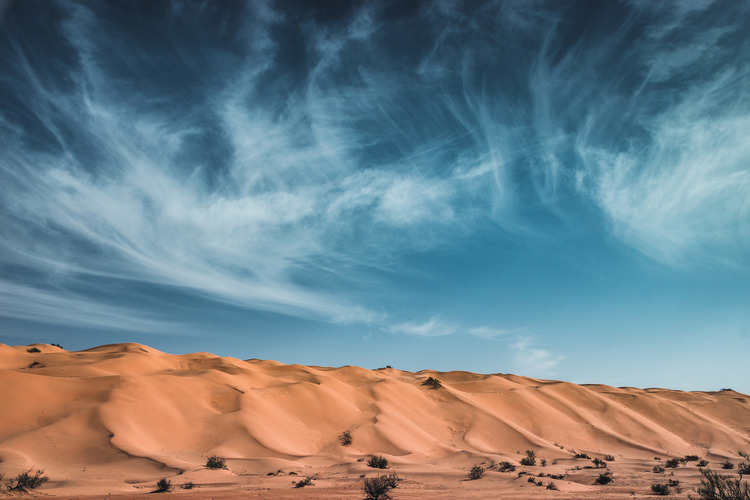
The world’s largest hot desert with extreme temperature fluctuations is home to around 2.5 million people and a variety of wildlife
by Victoria Heath
Stretching more than 3,000 miles from east to west, the Sahara is the world’s largest hot desert – approximately the same size as the United States. It is located in North Africa and covers nearly a third of the continent and part of eleven different countries.
The Sahara divides the continent in North and Sub-Saharan Africa, with the southern border marked by a group of semi-arid savannahs called the Sahel.
The name Sahara is an English pronunciation of the Arabic word for desert, ṣaḥrā.
History of the land of Sahara
Over the last few hundred thousand years, the climate of the Sahara has varied considerably between wet and dry.
The end of the last ice age caused the Sahara to experience a wetter climate between 8,000 BCE to 6,000 BCE, potentially due to low-pressure areas over collapsing ice sheets to the north.
After the ice sheets disappeared, the northern Sahara dried out – but soon, a monsoon came farther north to counteract the dry conditions in the southern Sahara. In around 2500 BCE, the monsoon retreated south and caused the Sahara to become a desert. For the past 13,000 years, the Sahara desert has remained at the same dryness.
Approximately every 20,000 years, the Sahara transforms into a savannah covered with lush grasses due to the angle of the Earth’s axis changing. This axis change causes the position of the North African monsoon to shift, a monsoon that could revive the Saharan region.
The current desert phase will last for around 15,000 more years before the Sahara will transform again into a savannah.
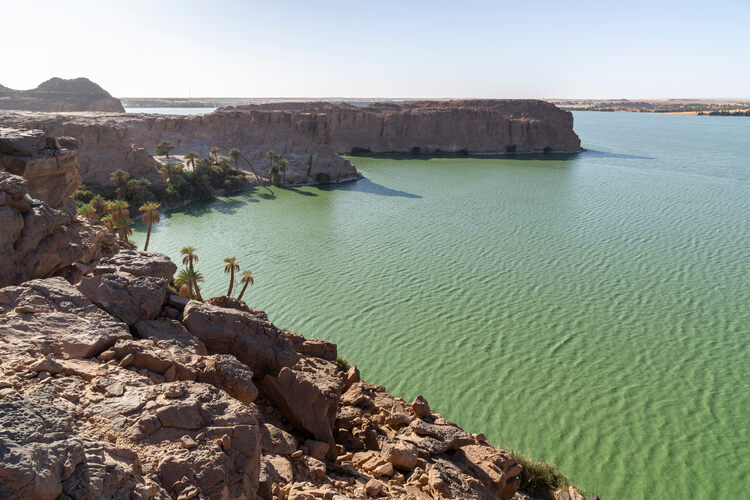
Around 10,000 – 12,000 years ago, the Sahara was a savannah inhabited by numerous animals. A 15,000-year-old Neolithic cave paintings in Algeria, depict wild animals including antelopes and crocodiles plus cattle herds and humans.
The 18 Ounianga lakes in northeastern Chad are located on the site of a former single lake dating back toaround 5,500 to 15,000 years ago. Today, the water in these lakes originates from water which accumulated in an underground aquifer during a humid period in the Sahara thousands of years ago.
Physiography of Sahara
The Sahara possesses topographical features such as shallow basins, large oasis depressions, plateaus covered in rocks, and mountains. However, the majority of the Sahara is comprised of hamadas, or rocky deserts, due to sand deflation (erosion by wind).
The summit of the extinct volcano, Mount Koussi, in the Tibesti Mountains in Chad is the highest point of the Sahara Desert, standing at 3,415 metres (11,204 feet). The lowest point is the Qattara Depression of Egypt, 133m (436ft ) below sea level.
Over 25 per cent of the Sahara’s surface is covered in sand sheets and dunes, with some pyramidal dunes reaching almost 150m (500ft). The highest dunes in the Sahara are found in the Isaouane-n-Tifernine desert in Algeria, with staggering heights of 420 to 465m (1,377 to 1,525 feet).
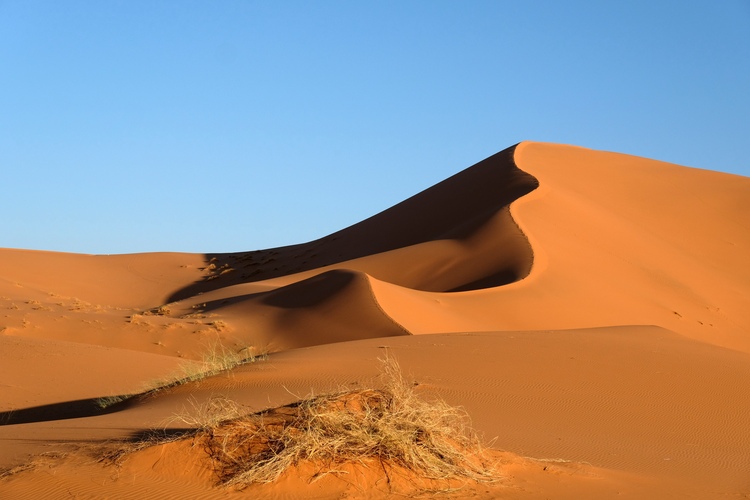
The sandy areas of the Sahara are called ergs, and are covered with sand dunes and shifting sands. The Grand Erg Oriental is one of the largest areas of sand desert in the Sahara, spanning parts of Tunisia and Algeria.
Despite these sandy, barren areas, the largest non-tidal lake in Central Africa is found in the Sahara. The water for Lake Chad is used by around 30 million people, as well as plants and animals. Yet in the last 50 years, most of the lake’s water has been lost due to human activities and climate change.
There are also around 20 salt lakes in the Sahara.
The only two deserts bigger than the Sahara are Antarctica and the Arctic.
The Sahara is also home to the ‘The Eye of the Sahara’ – or Richat Structure – a huge dome that resembles a blue bullseye, believed to be formed when the supercontinent Pangaea began to pull apart. It is 40 kilometres in diameter and exposes concentric rings of rhyolites and gabbros – igneous rock – created by erosion with a centre dome stretching for almost nearly 20 kilometres in width.
Able to be viewed from space, the rock formation is used as a visual landmark by astronauts, with photographs of the structure taken from the International Space Station.
Want to find out more about the Sahara?
The climate of Sahara
Characterised by aridity, strong winds, extreme temperature swings and low rainfall, the Sahara’s climate is particularly harsh. With less than one inch of rain per year – and sometimes, none at all – the Sahara may be one of the harshest environments on Earth. Around 17 per cent of the Sahara desert has an average rainfall of 0.2 inches (5mm) or less each year, with most of the rain occurring between December through March.
Between May to September, temperatures can reach over 50C (122F) in the day. At night, temperatures can plummet to around -6C (22F) during winter months, especially in the northern and southern edges of the desert.
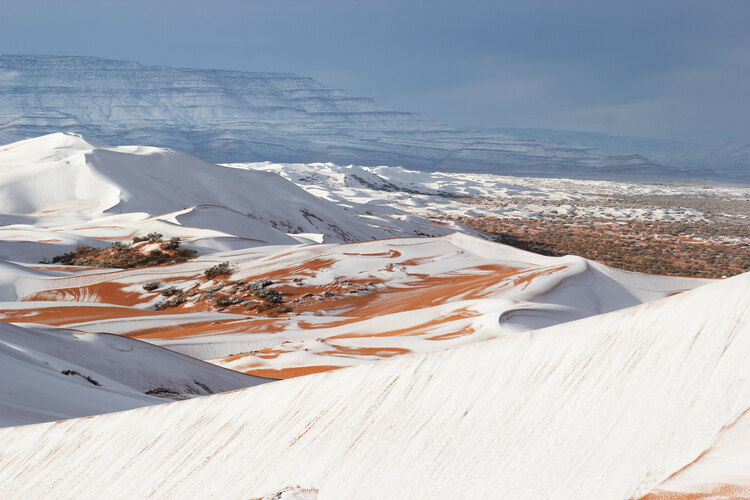
Due to the intense heat, when it rains, water quickly evaporates or is absorbed by the sand.
The intense winds in the Sahara can lead to dune fields, sand storms and dust devils (strong, relatively short-lived whirlwinds). Dust from the strongest wind, known as the harmattan, can be carried as far as the Atlantic Ocean. This dust plays a vital role in reflecting heat away from oceans, maintaining their temperatures.
In September 2024, however, the Sahara experienced an extratropical cyclone that drenched regions, with several villages in Morocco experiencing flash floods which damaged roads and electricity supplies. Rainfall reached up to 200mm in some areas – the quantity of rain normally expected in an average year in the Sahara.
While researchers found more than 38,000 heavy precipitation events occurred over the Sahara between 2000-2021, only a few were caused by extratropical cyclones in the summer.
Wildlife and plants in Sahara
Despite the challenging climate, the Sahara is home to various types of wildlife that have adapted to the demands of extreme temperatures.
In isolated oases of the Sahara in the Tibesti Mountains, pygmy crocodiles and cobras may still exist. Mammals that live in the desert include the gerbil, Cape hare and desert hedgehog, as well as the spotted hyena, sand fox and Libyan striped weasel.
Over 300 species of birds live in the Sahara, including migratory and resident species. These include ostriches, guinea fowl, desert eagle owls and fan-tailed ravens.
Snails that live in the desert provide an important food source for birds and animals, and can survive through dormancy when revived by rainfall.
In the lakes and pools of the Sahara, algae, brine shrimp and other crustaceans are present, as well as frogs, toads and crocodiles.
Plants that can grow in these regions are known as xerophytic and possess adaptations including heat-tolerant enzymes, succulent tissues and deep root systems – stretching from between 7 to 10 metres long – that penetrate into the ground to access water supplies. Many herbaceous plants in the Sahara are also known as ephemerals. This means that their life cycle is incredibly short – only a two or three-week period – after heavy rain falls in the desert.
There are scattered quantities of grasses, shrubs and trees in the highlands of the Sahara, with salt-tolerant plants (halophytes) found in saline depressions. Woody plants include species of olive, cypress and mastic trees.
History of human habitation
According to archaeologists, the Sahara was much more densely populated 20,000 years ago due to the less arid conditions. Artefacts including fossils and rock art have been discovered alongside remains of giraffes, elephants, buffalo, rhinoceroses, crocodiles, and aquatic animals.
Ten thousand years ago, gatherers and fishers reoccupied replenished lakes, streams and swamps – and traces of possible agriculture and cattle-keeping in mountains were found between seven and eight thousand years ago.
Due to worsening weather conditions, the population would leave for three to four thousand more years, except for those who lived in the Nile Valley.
Pre-dynastic Egyptians were herding cattle and constructing large buildings in the southwestern corner of Egypt by 6000 BCE. Between 633 and 530 BCE, Hanno the Navigator either established or reinforced Phoenician colonies in Western Sahara.
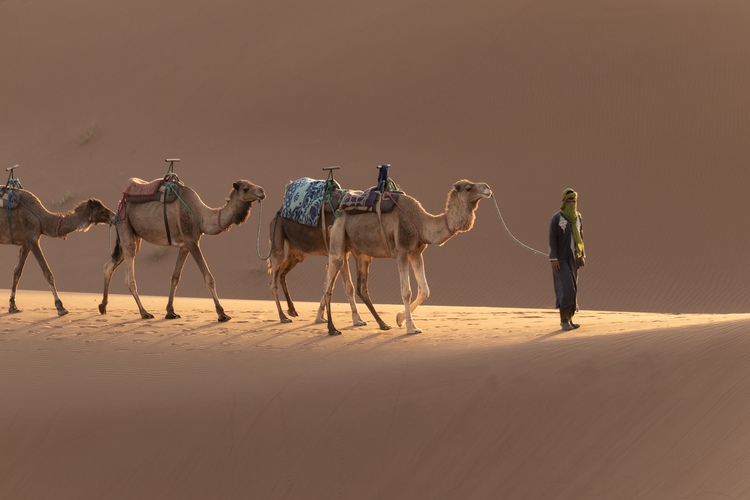
The Sahara was first crossed by oxen and horses in around 1,000 BCE, and these crossings became more common with the spread of domesticated camels.
By 500 BCE, Greek traders arrived along the eastern coast of the desert. As well as this, an urban civilisation called the Garamantes arose in the middle of the Sahara. The ancient Greeks and Romans considered the Garamantes to be uncivilised nomads but still conducted trade with them. Eventually, the Garamantes civilisation collapsed after the depletion of water availability.
This trade continued until the development in Europe of the caravel allowed ships, which sailed from Portugal and Western Europe to the desert to collect resources.
In modern times, the desert’s natural resources, such as large deposits of oil and natural gas in Algeria and Libya, as well as phosphate deposits in Morocco and Western Sahara have been exploited through mines and other communities.
The Sahara Desert is around the same size of the United States, and around 2.5 million people now live in the desert either – less than one person per square mile – in permanent settlements near water sources or travelling with herds of sheep, goats or camels as part of a nomadic lifestyle. Those who inhabit the Sahara mainly live in Algeria, Morocco and Mauritania.
Due to the discovery of oil and mineral resources, many people who were previously nomadic are now able to lead more sedentary lifestyles.
Still, notable nomadic groups live in the Sahara – these include the Tuareg, known as the ‘blue people’ due to their indigo clothing. As well as this, the Berber people reside in the mountainous regions of the Sahara, carrying out pastoralism, farming and trading.
In Morocco, a 150-mile-long ultramarathon known as the Marathon des Sables takes place in the Sahara. Spanning over six days, runners must sleep in tents at night in the desert, and carry everything they need for the race on their back.
Tourism in the region has grown since the mid-20th century, but difficulties in transport and accommodation due to the heat have meant most tourism occurs on the edges of the desert itself.




